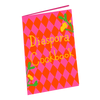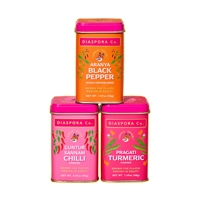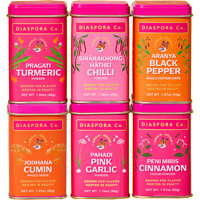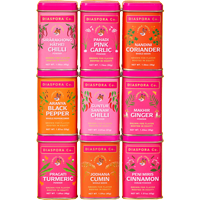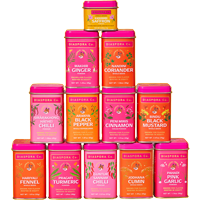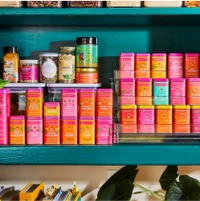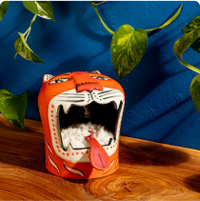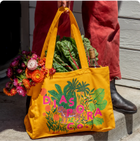My aunt Anjali Bhowmik and my mother Alicia Kuratomi de Bhaumik. My kakima’s kitchen was where I was first introduced to the spices of a Bengali village kitchen -- none of them were curry powder. West Bengal, India, 1976
---
Growing up, Japanese curry was the only thing we ate in our house that we called curry. It was also one of the first dishes I learned to make on my own. My mom, born and raised in Colombia to Japanese farmers, taught me to open a box, melt down the chocolatey looking block in water, and add meat and vegetables. She usually made the curry with chicken because my dad, a Hindu from West Bengal, avoided beef. To be clear, we ate plenty of Bengali food at home. There is just nothing called “curry” in my dad’s village in India. It was something my homesick dad learned to order in restaurants in America. Dishes that Westerners might call curry go by thousands of other names across South Asia — usually the names of the ingredients. Very few of them are the creamy tomatoey things you find in restaurants because those dishes... well, they were created in restaurants.
So what is curry? And how did this yellow powder make its way into national dishes across the world like curried goat in the West Indies, cà ri in Vietnam, sauce au curry in France, currywurst in Germany, curry powdered coronation chicken in Britain and, of course, kare raisu — curry rice— in Japan? Food historian Thy Tran once told me that curry is an inadequate word because it uses the language of the colonizer to describe the foods of the colonized. Kari is a tamil word with multiple meanings including the tree that produces curry leaves and included in many South Indian dishes (you can read all about it in Lizzie Collingham’s Curry: A Tale of Cooks and Conquerors). This word passed through Portuguese and then British colonizers, emerging as “curry” to describe a vaguely saucy dish prepared with spices.
You will find dozens of spices and a handful of blends in the cupboards of my dad’s village in West Bengal, but you will never find something called “curry powder.” The spices that make up curry powder have been eaten throughout South Asia for millennia in different combinations. During the occupation of India, the British were trying to make sense of the range of dishes and spices they were encountering for the first time (the classic comedy sketch Going Out for an English points out how ridiculous this all is). The first published English recipe for curry appeared in Hannah Glasse’s 1747 The Art of Cookery and the first known recipe for curry powder can be found in Mrs. Beeton's Book of Household Management. This is where the turmeric-heavy blend globally known as curry powder took form. A popular wedding gift for middle-class British brides, it was also taken to the colonies to provide guidance on managing servants in Australia and India who actually did the work. This meant that Indian domestic workers were taught to make appropriated versions of their own food, the caucasity.
So how did curry make the leap from Britain to become Japan’s favorite dish? The clues are in the ingredients. That shelf-stable block my mother taught me to use was basically a roux made of fat like palm oil or beef tallow. It also contains wheat flour, spices, and a sprinkle of MSG and preservatives. The European roux base is what gives Japanese curry its deep brown color. To this distinctly Western stew base is added classic Western stew ingredients — wheat to thicken, beef or chicken, carrots, potatoes, and peas. Like Mrs. Beeton’s recipe, Japanese curries are often sweetened with apple.

My two grandmothers: Lalitha Bhowmik cuts vegetables as Irma Hatsuka Kuratomi looks on from the edge of a diving board in Southern California. Bengali village homes have a pond that is central to food preparation. I can only imagine that the pool made my thakurma feel at home. California, 1976
---
According to an unlikely origin story from one of Japan’s leading commercial curry manufacturers, a starving Japanese boy hid himself aboard a British ship. Curry was served once a week by the British navy — the day that this boy happened to stow away. He was so delighted that he rushed home to tell his village about this wonderful flavor, spreading the news of curry throughout the land. You’ll notice in this tale that curry has very little to do with India. Kare raisu is considered yōshoku, Western food, referring to a style of dishes introduced in the Meiji Restoration (1868 - 1912).
So what really happened was that Japan was closed to the outside world for around 250 years. Foreign entry or Japanese departure was punishable by death. The Meiji era — coinciding with the height of British colonial rule — opened Japan to foreigners and created a militarized nation. Japan adopted the Gregorian calendar, moving the biggest holiday of the year — the new year and all of its food traditions — in line with the West and out of sync with the rest of East Asia. At the time, meat eating was restricted, not only because of Buddhism and Shintoism, but also because of the limitation of land. Wanting his people to, quite literally, beef up like the Europeans, Emperor Meiji publicly ate meat in 1872, officially lifting the ban on meat and changing the Japanese diet forever.
Beef and the curry that contained it was an expensive Western dish that only became more accessible after the introduction of instant curry in 1907. Over time and with industrialization, globalization, imports, and brutal colonization within and outside of Japan, meat intake skyrocketed. Hokkaido and its indigenous Ainu peoples were recolonized by Japan in the Meiji era as Japan perceived threats from neighboring Russia. Not so coincidentally, the region is now Japan’s largest agriculture producer including meat, dairy, and wheat. By the devastating Tokyo Earthquake of 1923 kare raisu stalls had popped up all over the city offering a complete, inexpensive, hearty meal. Its popularity also grew along with the Japanese navy. The military lured poor men with the promise of eating unlimited white rice. Many chose only to eat this luxury food, leading to a devastating vitamin deficiency. Kare raisu made with thiamine-containing meat and flour was the navy’s solution.

My aunt Lilia Kuratomi de Tsuchiya has taught generations of students how to cook kare raisu at the Japanese Colombian Association. The heart of Japanese communities in diaspora all over the world are established centers for cultural events, language classes, and elder care. Colombia, 2010
Even today in Japan, South Asian curries are seen as having different origins than Japanese curry. The first Indian style Indo Karii was introduced to Japan by Indian Ghadar revolutionary-turned-chef Rash Behari Bose. With a bounty on his life for his assassination attempt of Lord Hardinge, he fled from India to Japan in 1915. It just so happened that the family who sheltered Bose was not only a Pan-Asian movement supporter, but also owned a restaurant in Tokyo. Bose married the restaurateur’s daughter, began working there, and continued his political work, evading the British as they pressured Japan for his extradition. Where Japanese curry is thickened with wheat to a gravy-like texture, Bose’s original Indo Karii was apparently closer to a korma, thickened with nuts, cream, or yogurt. Today, Nakamuraya serves 6 billion plates of the freedom fighter’s recipe.
Like other yōshoku dishes, kare raisu became fast food, street food, home cooked food, and ultimately comfort food. The curry blocks are so ubiquitous that some people argue that it’s the only “authentic” way to prepare Japanese curry. But people in diaspora know that sometimes you have to reinvent the wheel with what’s available. My Tía Lilia who, like my mother, was born and raised in Colombia, passed her recipe for “Rice Kare: Arroz Con Curry” to me. It calls for a sauce base of curry powder, salsa inglesa (Worcestershire sauce literally translates to “English sauce” in Spanish), soy sauce, tomato sauce, and ketchup added to the homemade roux. Once I started reading labels I left the supermarket block and its preservatives behind and was left with a craving to get back to basics. After all, the ingredients add up to some semblance of a culinary self portrait for me — a mix of ingredients by way of South Asia, Britain, Japan, and Colombia only possible in the modern world.
-----------
Sita Kuratomi Bhaumik is an artist, writer and co-founder of People's Kitchen Collective based in Oakland, California on occupied Ohlone land. Her work has been called a "joyous political critique.” As an artist, she has built and destroyed a border wall made of piñatas and patterned the walls of a castle conservatory with curry powder. See more of her work at sitabhaumik.com, @sitabhaumik and peopleskitchencollective.com

